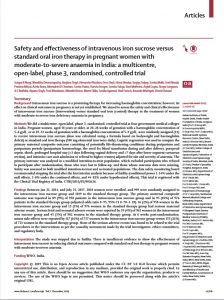
Background
Intravenous iron sucrose is a promising therapy for increasing haemoglobin concentration; however, its effect on clinical outcomes in pregnancy is not yet established. We aimed to assess the safety and clinical effectiveness of intravenous iron sucrose (intervention) versus standard oral iron (control) therapy in the treatment of women with moderate-to-severe iron deficiency anaemia in pregnancy.
Methods
We did a multicentre, open-label, phase 3, randomised, controlled trial at four government medical colleges in India. Pregnant women, aged 18 years or older, at 20–28 weeks of gestation with a haemoglobin concentration of 5–8 g/dL, or at 29–32 weeks of gestation with a haemoglobin concentration of 5–9 g/dL, were randomly assigned (1:1) to receive intravenous iron sucrose (dose was calculated using a formula based on bodyweight and haemoglobin deficit) or standard oral iron therapy (100 mg elemental iron twice daily). Logistic regression was used to compare the primary maternal composite outcome consisting of potentially life-threatening conditions during peripartum and postpartum periods (postpartum haemorrhage, the need for blood transfusion during and after delivery, puerperal sepsis, shock, prolonged hospital stay [>3 days following vaginal delivery and >7 days after lower segment caesarean section], and intensive care unit admission or referral to higher centres) adjusted for site and severity of anaemia. The primary outcome was analysed in a modified intention-to-treat population, which excluded participants who refused to participate after randomisation, those who were lost to follow-up, and those whose outcome data were missing. Safety was assessed in both modified intention-to-treat and as-treated populations. The data safety monitoring board recommended stopping the trial after the first interim analysis because of futility (conditional power 1·14% under the null effects, 3·0% under the continued effects, and 44·83% under hypothesised effects). This trial is registered with the Clinical Trial Registry of India, CTRI/2012/05/002626.
Findings
Between Jan 31, 2014, and July 31, 2017, 2018 women were enrolled, and 999 were randomly assigned to the intravenous iron sucrose group and 1019 to the standard therapy group. The primary maternal composite outcome was reported in 89 (9%) of 958 patients in the intravenous iron sucrose group and in 95 (10%) of 976 patients in the standard therapy group (adjusted odds ratio 0·95, 95% CI 0·70–1·29). 16 (2%) of 958 women in the intravenous iron sucrose group and 13 (1%) of 976 women in the standard therapy group had serious maternal adverse events. Serious fetal and neonatal adverse events were reported by 39 (4%) of 961 women in the intravenous iron sucrose group and 45 (5%) of 982 women in the standard therapy group. At 6 weeks post-randomisation, minor side-effects were reported by 117 (16%) of 737 women in the intravenous iron sucrose group versus 155 (21%) of 721 women in the standard therapy group. None of the serious adverse events was found to be related to the trial procedures or the interventions as per the causality assessment made by the trial investigators, ethics committees, and regulatory body.
Interpretation
The study was stopped due to futility. There is insufficient evidence to show the effectiveness of intravenous iron sucrose in reducing clinical outcomes compared with standard oral iron therapy in pregnant women with moderate-to-severe anaemia.